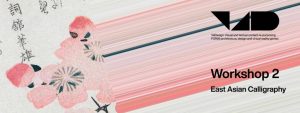 Dates: 6-8 April
Dates: 6-8 April
Hours: 10.00-18:00 pm
Participants : 30
Organizer: Innovative environments research unit / Aristotle University of
Thessaloniki
Website: Innovative Environments, V4Design
Online Training and Evaluation
Abstract:
The main idea behind the V4Design platform is to reuse visual: content such as movies, documentaries, paintings and images from other artwork, textual content from textual documentations in films, critics, catalogues, and repurpose it in a way useful for architects and video game designers. This pilot use cases are addressing issues of architectural design of indoor or outdoor elements that are related to East Asian Calligraphy and the way they can influence the actual design process.
Participants will be assigned to propose designs of interior or exterior objects using the V4Design platform. They will use V4Design as a tool to go through various forms of artworks, representations in order to extract 3D models and visualizations. 3D-models can be extracted by artworks of Japanese and East Asian Calligraphy but also from spatial elements and arrangements related to asian culture. These models will assist the design process of small scale objects (partition, furnishing). More specifically participants are going to access the V4Design web tool to select the material (3D models) of relevant elements (eg. Japanese characters, gardens etc). These objects will then be used as a base to set up their projects. This could be achieved either by distorting and altering the original 3D objects, or by taking pieces of several elements so they can in combination form a novel one. Aside from 3d objects, participants can also construct/extract 2D patterns, textures and materials that are later going to be applied on their 3D designed objects. The V4Design tool is going to assist the users during the formulation of their initial ideas by being used as a search engine, but also during the design process as it will be used to acquire already reconstructed 3d elements or reconstruct new ones necessary for the design process.
Each individual will formulate their strategies and deliver a design proposal for one of the following categories
- Partition
- furnishing
Goals and objectives
East Asian Calligraphy Workshop re-uses visual content, re-purposes/ develops approaches for 3D reconstruction/modelling of objects deploying innovative design authoring applications.
Direction/ Brief
The workshop involves the design of small scale indoor and outdoor architectural elements related to East Asian Calligraphy and focuses on two different design directions.
- Partition:
Encourages design experimentations/approaches for a partition element of interior or exterior use. Proposals may cover needs of division and involve various elements (such as walls, screens, shades, fences, curtains, banners, and vertical surfaces) at any scale. Further appropriations of lighting, texture and any other special effect are welcome.
(deliverables: plan, section, elevation, renders, scale 1:10-1:100, 2 page written report)
- Furnishing:
Encourages design of one or more pieces of furnishing equipment. Those may cover visitors’/users’ needs of rest/leisure to indoor or outdoor areas (waiting areas, coffee dining areas). They may take the form of a functional element (i.e. bench, stool, coffee table, bin or fountain, etc).
(deliverables: plan, section, elevation, renders, scale 1:10-1:100,2 page written report)
Agenda
Day 1 (10:00 am -18:00 pm) Introduction and Training Day
10:00-10:30 – Opening introduction
10:30-11:00 – Introduction to the V4Design workshop objectives
11:00- 13:00 – Guided exercises/walkthrough to the platform
13:00 – 14:30 – Experimentation with the platform
14:30- 15:00 – Break
15:00-17:00 – Brainstorming and project development
17:00- 18:00 – Discussion of ideas (short presentation)
Day 2 (10:00 am-18:00 pm) Design and Training Day
10:00- 13:30 – Development of projects
13:30- 14:30 – Progress feedback
14:30- 15:00 – Break
14:00-17:00 – Development of projects
17:00-18:00 – A short presentation of each one’s ideas and progress
Day 3 (10:00 am -18:00 pm) Evaluation Day
10:00- 14:30 – Development of projects
14:30- 15:00- Break
15:00 – 18:00 – Project presentations
18:00 – 19:00 – Questionnaires (Quick walkthrough and explanation of the Questionnaire)

